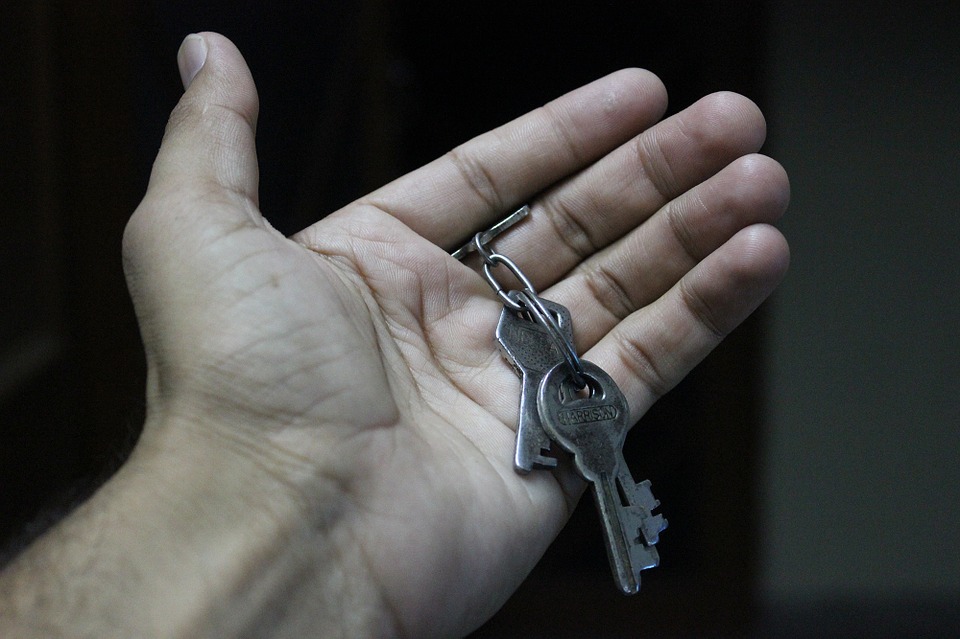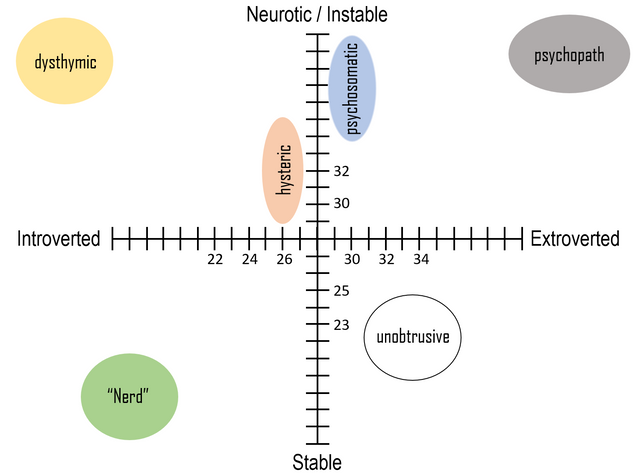Psychological Personality incl. Evaluation Key
This post comprises the evaluation key for the placement test promised yesterday and gives basic information on characteristic personality types and models. (Find the first article with the test questionnaire here.)

Quelle: pixabay
The Test Evaluation
Each of the questions asked is assigned to one of the two main dimensions (Extraversion vs. Introversion / Stable vs. Neurotic) and gives, according to your answer, either +2, +1 or +0 points for the axis along this dimension. I prepared an example to illustrate this:
Question 2: (N/Yes)
The first letter in brackets represents the corresponding dimension. In this case it is the N-axis, which is the axis from stable to neurotic.
The answer given next is worth +2 points for this dimension.
The question mark always means +1 point.
The opposite answer is +0 points.
After evaluating all questions according to the following list, sum up all points for the N - and E-dimension. Now you can find the position of your structure of personality in the model according to Hans Jürgen Eysenck.
Question 1: (E/Yes)
Question 2: (N/Yes)
Questione 3: (N/Yes)
Question 4: (E/Yes)
Question 5: (E/Yes)
Question 6: (N/Yes)
Question 7: (N/Yes)
Question 8: (E/Yes)
Question 9: (E/Yes)
Question 10: (N/Yes)
Question 11: (N/Yes)
Question 12: (E/Yes)
Question 13: (N/Yes)
Question 14: (E/No)
Question 15: (N/Yes)
Question 16: (E/No)
Question 17: (N/Yes)
Question 18: (E/Yes)
Question 19: (N/Yes)
Question 20: (E/Yes)
Question 21: (N/Yes)
Question 22: (E/No)
Question 23: (N/Yes)
Question 24: (E/No)
Question 25: (N/Yes)
Question 26: (E/Yes)
Question 27: (N/Yes)
Question 28: (E/Yes)
Question 29: (N/Yes)
Question 30: (E/No)
Question 31: (N/Yes)
Question 32: (E/Yes)
Question 33: (N/Yes)
Question 34: (E/Yes)
Question 35: (N/Yes)
Question 36: (E/No)
Question 37: (N/Yes)
Question 38: (E/Yes)
Question 39: (N/Yes)
Question 40: (E/No)
Question 41: (N/Yes)
Question 42: (E/Yes)
Question 43: (N/Yes)
Question 44: (E/Yes)
Question 45: (N/Yes)
Question 46: (E/Yes)
Question 47: (N/Yes)
Question 48: (E/Yes)

The Model of Personality according to Hans Jürgen Eysenck.
Illustration is self-made.
The generally better-known Doctrine of Humors by Galen is considered a historically important foundation for modern models, but is otherwise obsolete. Galen was a Greek physician who developed a personality profile typology, which is now more than 2000 years old, based on empirical observations of his patients. He introduced four different types:
Melancholic Type:
levelheaded, pessimistic, unsociable, calm, timid, moody, rigid,...Choleric Type:
restless, sensitive, excitable, aggressive, fickle, spontaneous, optimistic, active,...Sanguine Type:
sociable, open-minded, talkative, approachable, lively, light-hearted, lazy, executive,...Phlegmatic Type:
peaceful, thoughtful, passive, careful, quiet, controlled (externally), reliable, steady emotions,...
Here I should mention that hardly anyone can be assigned 100 % to exactly one of these types. In most cases it is a hybrid with a dominant component. The four Galenic types can - if you want - be overlayed with the four quadrants of the model presented above:
I/N = Melancholic Type
I/S = Phlegmatic Type
E/S = Sanguine Type
Finally, a few words about the special forms of personality profiles listed in the figure above:
A hysteric can show various typical traits, including Nazism (excessive need for admiration), egocentrism (self-centered, inclination to self-portrayal) and also infantile behaviour (childish need for attention). The hysteric likes to live out his inner dissatisfaction in dramatic ways.

Source: pixabay
The psychosomatic has problems dealing with emotional conflicts. Therefore internal conflicts build up and lead to surprising, totally real physiological consequences. If this circumstance is spotted as a reason for a real burden or danger, this person should turn to psychological help. According to our professor psychosomatic traits are well treatable.
A dysthymic type may be considered an extreme form of the melancholic type, since the second one can already be referred to as a pre-stage for a depressive personality. They are latent and chronically depressed people. Dysthymia can worsen in phases and is accompanied by typical depressive symptoms like:
joylessness, inappetency, fatigue, exhaustion, sleep disturbances, low self-esteem, concentration disorders, hopelessness, anxiety states, irritability, etc.

Source: pixabay
Psychopaths are characterized by some very characteristic features: They are unable to experience empathy and are pathological liars. Furthermore, they have a lack of remorse, tend to be promiscuous, and regularly change partners throughout their lives. A psychopath is typically sensational, egocentric and rather emotionless. Some assume that the reduced emotional involvement is the reason why such persons are particularly attracted to sensations and extraordinary (possibly even criminal) events, as they finally get the emotional excitement they want and need. The fact that psychopaths are maximal self-centered leads to the general agreement, that they have to be considered as incurable by any psychological therapy.
I guess there is no big need to describe the 'Nerd' or the socially ordinary. The first one is very focused on everything he is interested in, but everything else leaves him untouched. The second one interacts much more actively with his surrounding. Both have considerable social competences, which make them quite sociable. The 'Nerd' is relatively easy to compromise, is comparatively objective and tolerant, the unobtrusive type is quick-witted, spontaneous, open-minded and warmhearted.
mountain.phil28
References:
- MPI Persönlichkeits Einstufungstest, ausgehändigt von Prof. Enrique Grabl Dez. 2017
- H. J. Eysenck, The structure of human personality, 1970. London: Methuen.
- Temperamentenlehre, ein Wikipedia Artikel, aufgerufen am 21.03.2018
- V. Faust, Hysterisch - Was heisst das?, Psychosoziale Gesundheit, aufgerufen am 21.03.2018
- V. Faust, Dystymie: Chronisch depressive Verstimmung, Psychosoziale Gesundheit, aufgerufen am 21.03.2018
- P. Netter, J. Hennig: Biologische Persönlichkeitstheorien. In: H. Weber und Th. Rammsayer (Hrsg.): Handbuch der Persönlichkeitspsychologie und Differentiellen Psychologie. 2005, Band 2 S. 71 ff.
I don't know how to interpret my results, maybe I did it wrong. I calculated results by adding up either E or N,
So E= 10 points N = 29 points
So you don't fall into one of the typical personality profils that we discussed. You are almost perfectly in the middle on the stability/neurotic axis, but rather strongly offset towards an introverted personality. You are somewhere between a typical nerd and a dysthymic person. Or in other words: you bear/combine characteristcs of the phlegmatic and melancholic type.
INTP in myers briggs so pretty spot on ^__^ That being said I haven't looked into the actual scrutiny of the process as a science, and I believe there's a more more modern, updated equivalent somewhere I read about a while ago. Will have to check that stuff out too!
Now I can't wait to get home and check the piece of paper with my answers!
Oupsidaisy don't get into an accident (if you are in your way by Car or Bike) 🙄😄
I'll be careful! No worries! :)
I checked my answers! The results were as I had expected ;)
Interesting... Seems like i am the only person, that was ever surprised by its results.😅
Maybe you hadn't done much self-questioning :P
Being A SteemStem Member